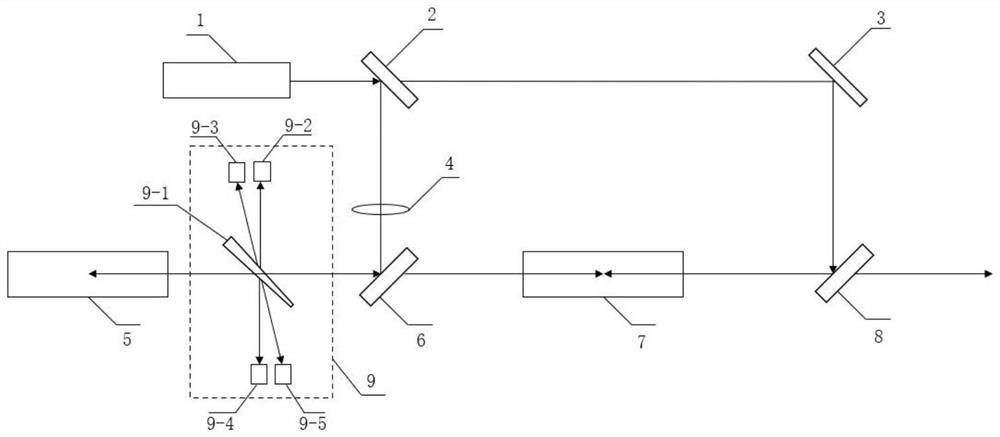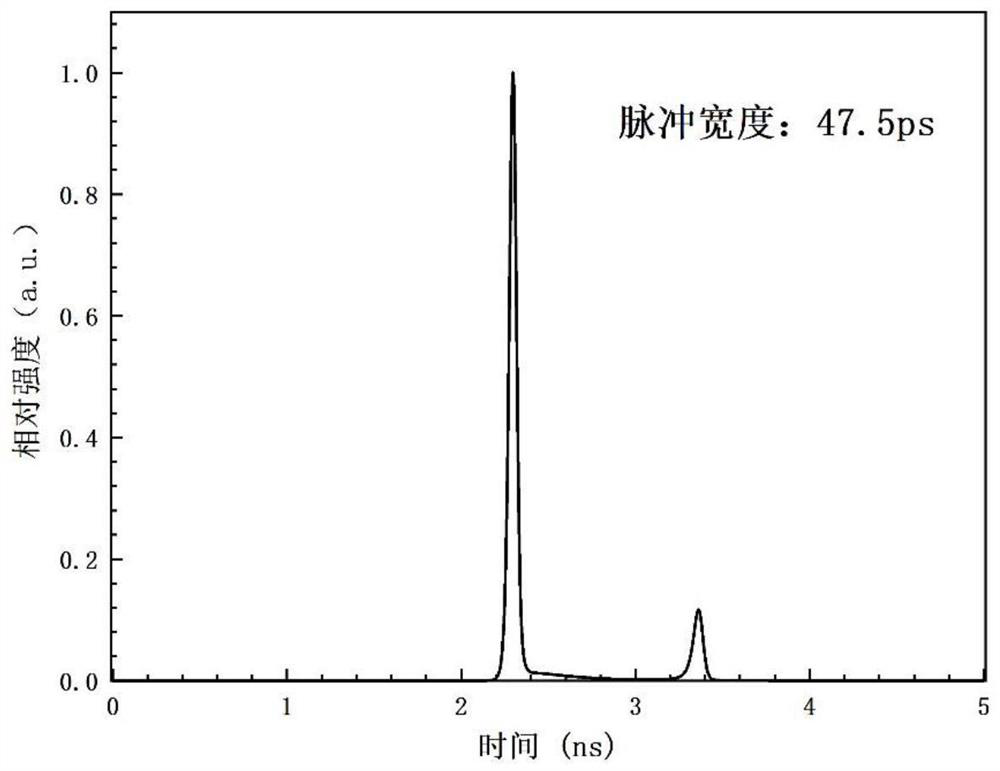Ultra-short pulse laser generating amplification structure based on stimulated Raman scattering
A technology of stimulated Raman scattering and ultrashort pulses, which is applied to lasers, laser components, and lasers using scattering effects, etc. It can solve problems such as high compression limit of Q-switching technology, low energy of mode-locking technology, and narrow ultrashort pulses. , to achieve the effect of good waveform, good compression effect and wide gain bandwidth
- Summary
- Abstract
- Description
- Claims
- Application Information
AI Technical Summary
Problems solved by technology
Method used
Image
Examples
Embodiment 1
[0045] Embodiment 1: the pump source 1 selects a single longitudinal mode laser with a wavelength of 1064 nm and a pulse width of 1 ns, the focal length of the convex lens 4 is 10 cm, the length of the SRS generation pool 5 and the SRS amplification pool 7 are both 10 cm, and the two dielectric pools Select the Raman frequency shift as 1047.3cm -1 , Ba(NO 3 ) 2 The crystal finally outputs Stokes seed light (first-order output) with a wavelength of 1197nm. The optimal pulse output is obtained by adjusting the output energy of the laser and the fraction of the beam splitter 2. At this time, the measured energy conversion efficiency is 15%.
Embodiment 2
[0046] Embodiment 2: the wavelength used by the pump source 1 is 1064nm, the divergence angle is 0.45mrad, the peak power is 2.1MW, and the pulse width is 1ns; the medium selection Raman frequency shift in the SRS generation pool 5 and the SRS amplification pool 7 is 1047.3cm -1 , Ba(NO 3 ) 2 Crystal, the cell length of SRS generation cell 5 and SRS amplification cell 7 are both 10cm, the focal length of convex lens 4 is 16.2cm, the distance between convex lens 4 and the cell mirror of SRS generation cell 5 is 10cm, and other device models are not limited. The numerical simulation results of this example are as follows image 3 As shown, the laser pulse output with a wavelength of 1198nm and a pulse width of 47.5ps was finally obtained.
Embodiment 3
[0047] Embodiment 3: The difference between the parameters in this embodiment and Embodiment 2 is that by changing the Raman gain coefficient of different media and the numerical simulation of the phonon lifetime of the medium; Figure 4 It is the numerical simulation diagram of the phonon lifetime of 80ps and the gain coefficients of 3cm / GW, 7cm / GW, 11cm / GW, 15cm / GW and 19cm / GW at 1064nm, and the corresponding pulse widths of the laser pulse output are 78ps and 56ps respectively , 47.5ps, 45.5ps and 43ps; Figure 5 It is the numerical simulation diagram under the gain coefficient of 11cm / GW at 1064nm, and the phonon lifetimes are 0.02ns, 0.05ns, 0.08ns, 0.11ns and 0.14ns respectively, and the corresponding pulse widths of the laser pulse output are 40ps, 44.5ps, 47.5 ps, 53ps and 56.5ps.
[0048] It can be seen from the figure that the larger the gain coefficient, the shorter the Raman active medium with the phonon lifetime is, the more helpful it is to obtain the pulse outp...
PUM
| Property | Measurement | Unit |
|---|---|---|
| wavelength | aaaaa | aaaaa |
| Gain coefficient | aaaaa | aaaaa |
Abstract
Description
Claims
Application Information
 Login to View More
Login to View More - R&D
- Intellectual Property
- Life Sciences
- Materials
- Tech Scout
- Unparalleled Data Quality
- Higher Quality Content
- 60% Fewer Hallucinations
Browse by: Latest US Patents, China's latest patents, Technical Efficacy Thesaurus, Application Domain, Technology Topic, Popular Technical Reports.
© 2025 PatSnap. All rights reserved.Legal|Privacy policy|Modern Slavery Act Transparency Statement|Sitemap|About US| Contact US: help@patsnap.com



